32 Mutations for A.P. Looze’s
I Can See The Sky
A window into a performance space that is both receptive and projective, funny and wrenching, banal and cosmic, of this world and another

On June 28 and 29, 2024, All of the Above presented I Can See the Sky, a performance by A.P. Looze, at Red Eye Theater in Minneapolis. On Red Eye’s website, A.P. described the show as a multimedia honoring of presence. Underneath my presence there are odes to so many things including but not limited to god, tears, black holes, grandmas, Tammy—my mom’s manicurist, and the ghosts of unimaginable loss. I’ve cried a lot this year. This is my heart, in real time. The show was introduced with an epigraph by Louise Glück: At the end of my suffering / there was a door.
1. The thing about a solo show is you are never really alone. As lonely as a quaking aspen. And yet, if actualized, the enchantment of the solo show is its delusion of aloneness. The artist’s and the witness’s.
2. Synecdoche is the tree standing in for the grove. The boots for the soldier. The hand for the person needed to help. The head for the whole cow. Synecdoche comes from the Greek sunekdokhē, from sun- ‘together’ + ekdekhesthai ‘take up.’ I like that sun denotes togetherness. In homophonic extension: When the lights go up, like the sun, we see we are all together. But I’m getting ahead of myself.
3. Taken literally, synecdoche’s figures make for a cartoon universe in their singularity.1 A battlefield of empty boots skirmish. Disembodied hands wander the world in search of work, while cow heads levitate in the pasture. It would be like only seeing a checked box on a government form2 for race, ethnicity, sexual orientation, or gender, and making it a pigeon hole, censoring the much larger, mutant human organism. Or forgetting it is part of the much more vast, strange, miraculous superorganism called earth.
4. Or, you might, like A.P. Looze, come from elsewhere in the galaxy. Sagittarius A*, to be exact, as an alien informed them in a dream. The super massive black hole at the Galactic Center of the Milky Way. The human stands in for the galactic.
5. Synecdoche: taking up together. I Can See the Sky. The sky for eternity. In Shelley’s “Mutability”–We are as clouds that veil the midnight moon. / How restlessly they speed and gleam and quiver…3
6. It feels limiting to think about A.P.’s one-person show of singing, storytelling, animation, divination, light refraction, and weeping–a significant amount of weeping–as a performance the same way the performance of identity feels limiting. To witness A.P. weeping in I Can See The Sky is to witness a kind of bravery, and embodiment, in a world of cognitive bias and distraction: I’ve really needed godliness this year, some sort of holiness, higher power, what have you. it’s so funny, when things fall apart, sometimes the most tangible and understandable and reliable thing to hold onto is mystery.4
7. Did people write critical reviews of the mystic and memoirist Margery Kempe’s public displays of weeping? Did she have to write a grant, rent a space to weep?
8. It’s like the case of Rumi’s tripe:
As for these friends who come to see me,
for fear lest they should get bored,
I say a piece of poetry,
so that they may occupy themselves with that.
Otherwise, what is poetry to me?
By God, I tell you I loathe poetry,
and as far as I’m concerned there’s nothing worse than that.
It’s just like someone who has put his hand into some tripe,
And is washing it for the sake of his guest’s appetite is for tripe
I have to do it . . .5
9. Tripe is a cow’s first or second stomach (now we’ve found another part affiliated with those floating cow heads). A receptive organ critical to the cow’s metabolism. It’s also, in English, a word for “rubbish” or “nonsense.” Tripe!
10. I think about Margery Kempe a lot after A.P.’s show. For, like Margery Kempe, A.P. is a mystic, and like many mystics, A.P. might be misunderstood.
11. Many have accused Margery Kempe of tripe. In her time and even today. There’s a remarkable timeless aversion to this medieval pilgrim and mystic. The 20th century temptation was to pathologize her–as a neurotic, as an epileptic, as one suffering, after 14 children, from postpartum psychosis. According to Anthony Bale, a translator of The Book of Margery Kempe into modern English: People think she’s a whiner. She’s a liar. She’s a moaner, a kind of self-seeking attention whore, which is the phrase that one person used on Twitter. They regard her as a fake.6 This is extreme vitriol for a woman 400 years dead. A button spanning the time-space continuum has been pressed. What’s underneath this aversion to her “God-given weeping”? The horror of the possibility we might be porous? Uncontainable? Uncontrollable? That the force of life exceeds us, is divine, that we can’t control it? In a world where women were forbidden from preaching, weeping was a form of expression, if not also commentary, a direct line with the divine.
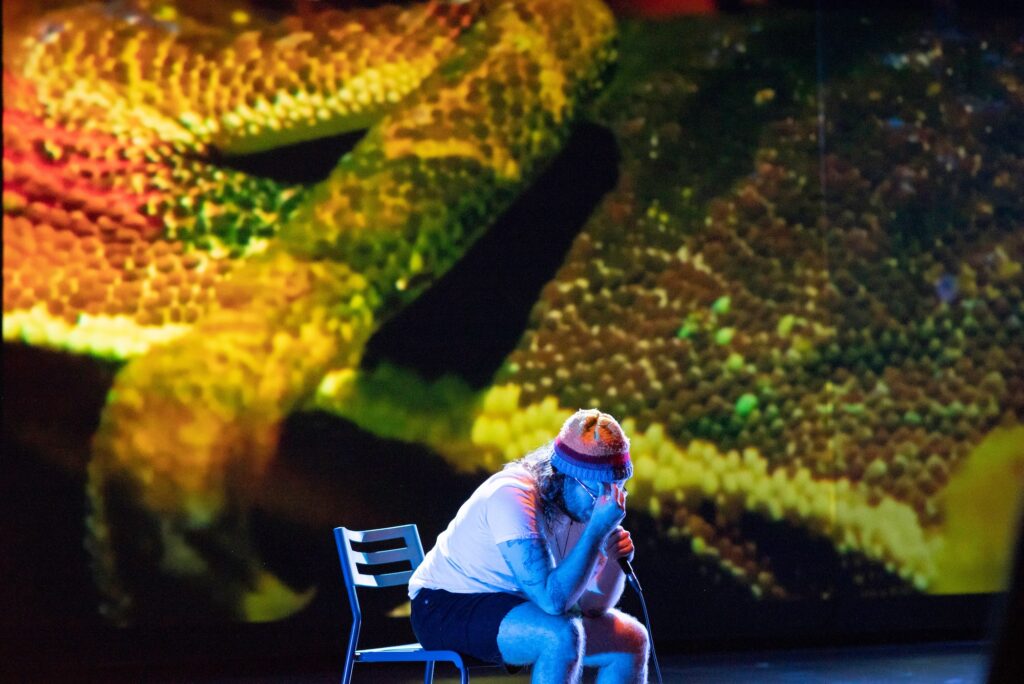
12. In our country and among our people, Rumi concludes, there was nothing more disgraceful than composing poetry.7 Oh the terror and the unexpected pleasures of falling from grace. Working at the bottom, in Kristeva’s realm of the abject: What disturbs identity, system, order. What does not respect borders, positions, rules. The in-between, the ambiguous, the composite.8 The poetry, ugh the poetry, its metaphorical and metonymic wildness. It seems that A.P. made what they made to say what they had to say through the window they found in this time, this place. At the end of their suffering was a window.
13. Synecdoche is a kind of metonymy. The shuffling of kindred words. Metonymy–from French métonymie (16c.) and directly from Late Latin metonymia, from Greek metōnymia, literally “change of name.”
14. In the magic of metonymy we can hear John Muir’s When we try to pick out anything by itself, we find it hitched to everything else in the universe.9
15. Metonymy is like surface glimmers that rhyme on the eternal sea of flux, the energy that moves through us and past us, that rises up and falls down, that rushes and lingers, that crashes and swirls and freezes and melts and always, is always, in flux.
16. The term black hole is of very recent origin.10 What were you before your name?
17. In the city of slow entrances, there is immense attention given to thresholds. Attention by way of presence. Presence by way of being bodied. Bodies in slow dialogue with the unseen. Crowned by time.
18. What Carlo Rovelli writes about the horizons of black holes has me thinking of A.P.’s entrance in I Can See The Sky: In sum, close to the horizon, time slows in the sense that anyone observing us from afar would see us moving in slow motion…11
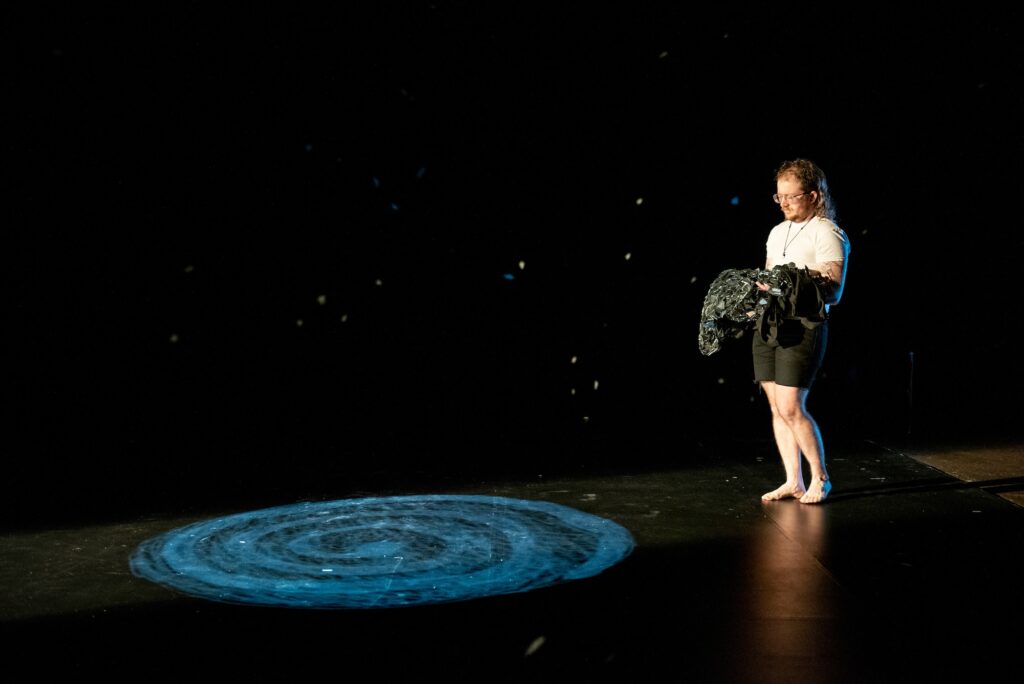
19. A.P. enters the black box carrying a baby a bundle, something slack and crumpled, a funerary veil, a black cape covered in mirror shards. They are walking as if having left something behind. In my memory of this entrance, although I know it not to be actual, dust emanates from A.P. There is a sense they have fallen a long way. That the disco ball has shattered, that the glass lover broke into a thousand shards. That this place–where they enter–is rock bottom. The bottom of a well, a hole. The bottom of a black hole.
20. Rock bottom. Where we find in its ineluctable gravity, our will. A.P. sings: There is a part of me who wants to live. / There is a part of me that doesn’t want to die. We don’t know exactly what has happened to A.P. to get them to this place. There is no story in this regard, just this: i’ve had, for lack of a better term, an incredible year. full of many tears. i’ve cried innumerable times, in innumerable places in innumerable ways. i’ve been contending with my own realness, feeling unreal and then real, toggling between the two, feeling like an intermittent illusion. There are many things that can bring us down. Writes alchemist and writer Catherine MacCoun: We are carried downward whenever we feel ourselves losing control. Anything that makes us feel helpless will get us there–illness, depression, grief, addiction, shame, rage, anxiety, PMS. In vertical terms, to be helpless is to be heavy. Surrendering makes the downward journey swifter and a tad less painful, but gravity is going to take you down whether you choose to surrender or not.12 That A.P. doesn’t confess what got them here is important because it’s not the point. Their surrender is what matters, and it requires our trust as witnesses, to take them at their word, to surrender to their word that bad things went down.
21. Surrender is a disarming process in which we’re left exposed, entirely vulnerable. Scary! In a heady, anxiety-driven culture this is a worst case scenario. Our old defenses and stories and identities no longer work–they’re tripe! It’s not unlike the trust one might have to find in the case of unremembered trauma–that it may not ever be known what exactly happened, that narratives could be built and dismantled and rebuilt but the point is here you are on the floor weeping while the frozen world thaws and you have to surrender to the feeling.
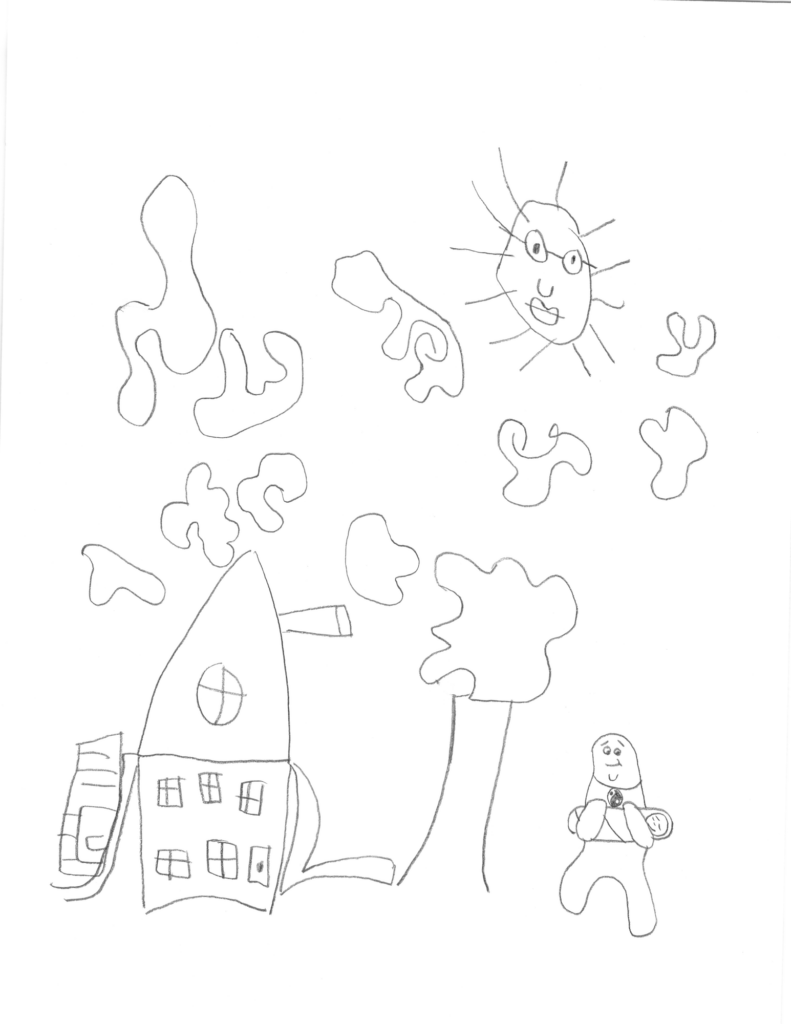
22. The morning of the Saturday I see A.P.’s show, I go to the Midway Menards with my daughter on a mission to get a ladder. If you are familiar with this massive hardware and home goods complex you will probably understand what happens next. We arrive at the store and suddenly I have no idea why I think we need a ladder, so we wander instead. We ride the flat, slowly ascending conveyor to the upper level, and because it is only as wide as the shopping carts, and a couple with a shopping cart is standing still in front of us, we go as slow as this uncannily slow conveyor, towards the lights department gleaming like a crazy cluster of stars, and it is as if everything in the store has lost its functional value and bears no significance to us. Where are we? Who are we? To help, there’s a piano at the top of this conveyor belt of being. A man, bearing a remarkable resemblance to the sculpture of the Hermit Saint at the Minneapolis Institute of Arts, plays Joni Mitchell’s “Both Sides Now” on the piano–as if in serenade to an existential reckoning and ice cream castles in the air / And feather canyons everywhere / I’ve looked at clouds that way / But now they only block the sun / They rain and snow on everyone / So many things I would have done / But clouds got in the way. The speed of A.P.’s first entrance evoked this conveyor moment for me, and, as if in verification, we learn in their monologue that the conveyor walkway at the Midway Menards was among the places they wept.
23. I Can See The Sky opens up a sacred in-between, a midway space, if you will, one that finds, in Louise Glück’s words, that At the end of my suffering / there was a door13–a space that is both receptive and projective, funny and wrenching, banal and cosmic, of this world and another. Of rock bottom, MacCoun writes: No matter how hard you struggle, eventually you have to acknowledge your helplessness. At that point you find you’ve landed in a surprisingly soft space. Benevolent beings gather up the pieces you’ve fallen to and put them back together in a new and better way. In the way that this disarming piece of theater might be an act of service, A.P. proceeds to show us in this black hole how to pick up the pieces and don a resplendent astral dreamcoat.
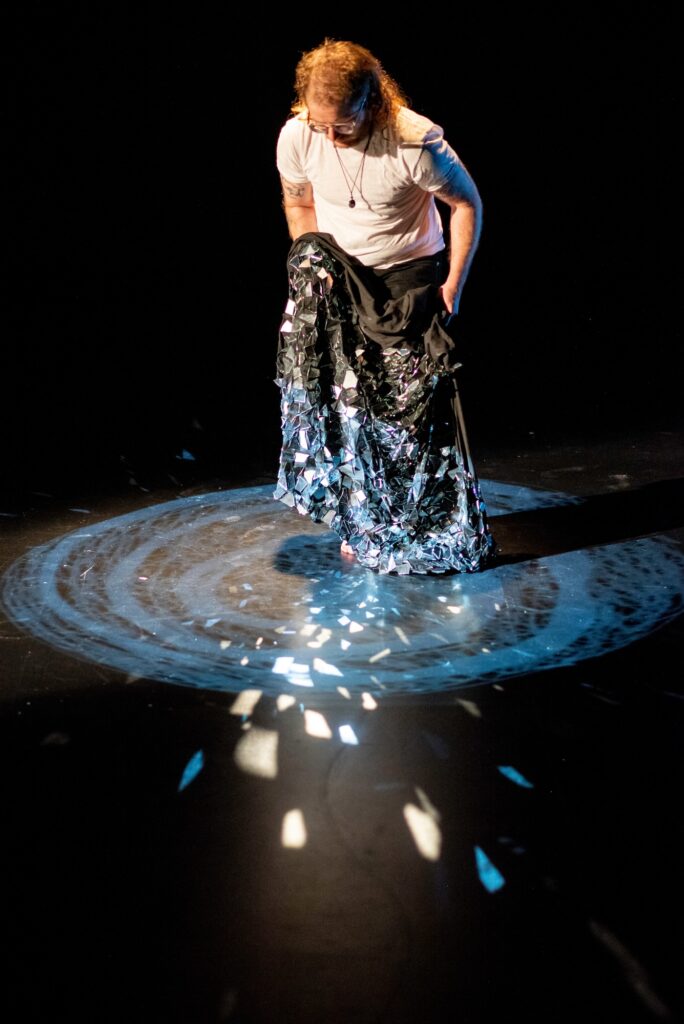
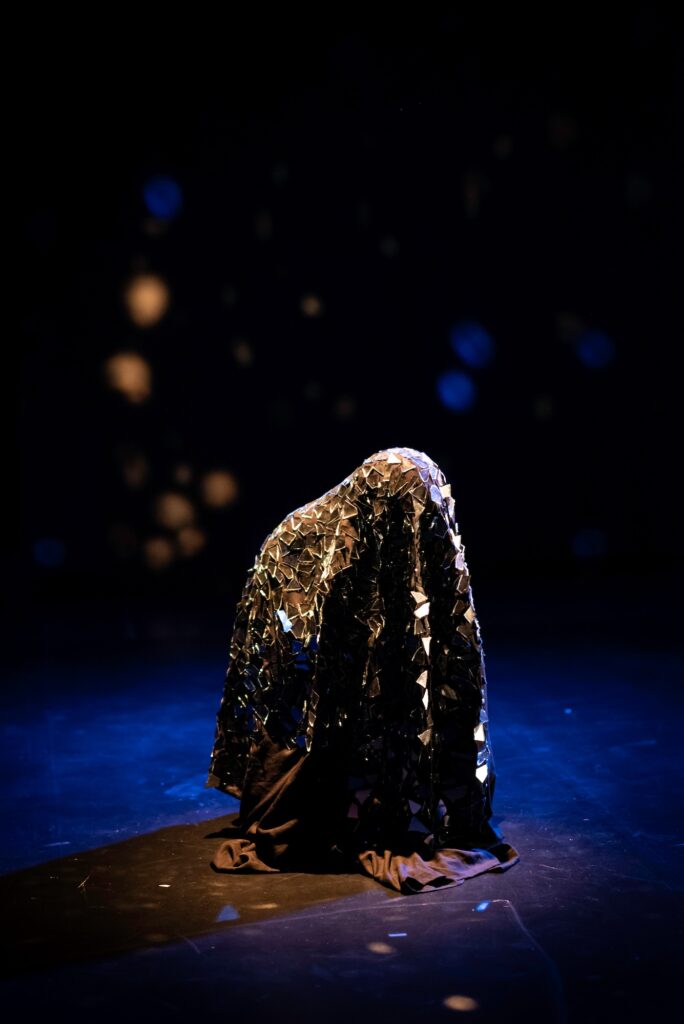
24. Early on in the show A.P. mentions this thing called hawking radiation. discovered by stephen hawking. and when it comes out of a black hole, it makes the black hole evaporate, literally disappear, but over like, billions of years. and it’s thought that the hawking radiation may be a scrambled quantum message of all that went into the black hole, as it is emitting the story of its life before death. Bridging the cosmic to the terrestrial, A.P. tells us of a video they came across while making the show of a chameleon dying. In its final moments it flickers and flashes a spectrum of colors as if emitting its own hawking radiation, A.P. says, the story of its radiant colorful life before death. In the show’s final moments we are presented with this spectacle projected large onto the screen behind A.P.
25. Here I hear the Sufi poet Rabi‘ah al-Basri: Ironic, but one of the most intimate acts of our body is death. So beautiful appeared my death–knowing who then I would kiss, I died a thousand times before I died.
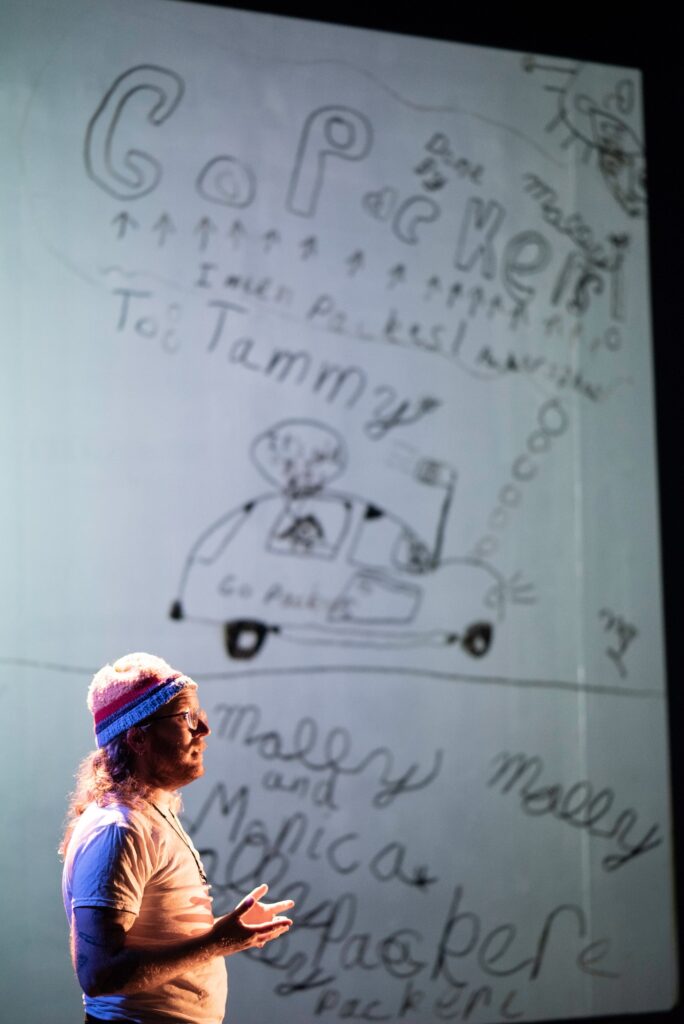
26. What presences and colors/stories populate and radiate from this black hole? A.P.’s grandmothers are invoked, a handknit hat and sippy cup their talismanic representatives; Tammy’s Nail Salon as a cosmic space in which A.P. first consciously experiences God; Joan Osbourne on VHS crooning “If God had a name what would it be?”; a sketchbook a young A.P. doodled in while their mom got a manicure by Tammy, its endearing pages of Green Bay Packers fan art and portraits of thin-necked people wearing yin yang necklaces, signed “Molly” in careful cursive; the many A.P.s that sang with each other through the layers of the looping pedal, each one repeating a phrase, and then a moment when A.P. closes their eyes and goes inward: now i’m going to listen. . . i want to ask the sky more about what god is, and just pay attention to anything that comes through. At this point, and though it is not the first, A.P. shifts to a receptive mode and goes off-script, in this case an oracular mode in which they repeat what they are receiving: a series of sentences beginning God is… For example, per my notes: God is a series of concentric realities. God is refracted light and its beauty. My handwriting veers illegible, but I vividly remember at a certain point, God got replaced with Time. This shift felt profound and revealing. That the god/clock/linear time we worship is only one version or expression of more mysterious, fluid times in flux. Writes Carlo Rovelli, in response to the idea there is no absolute time: it seems to me to be the source of a gentle dizziness, the dizziness of lightness, of the intoxicating inconsistency of that delicate texture that is the reality of which we are part. / we have access only to perspectives. . . there is no absolute. We are limited, impermanent, and precisely for this reason, to live, to be as we do, is so light and sweet . . . 15 The last thing I scrawled: Let yourself become a feeling.
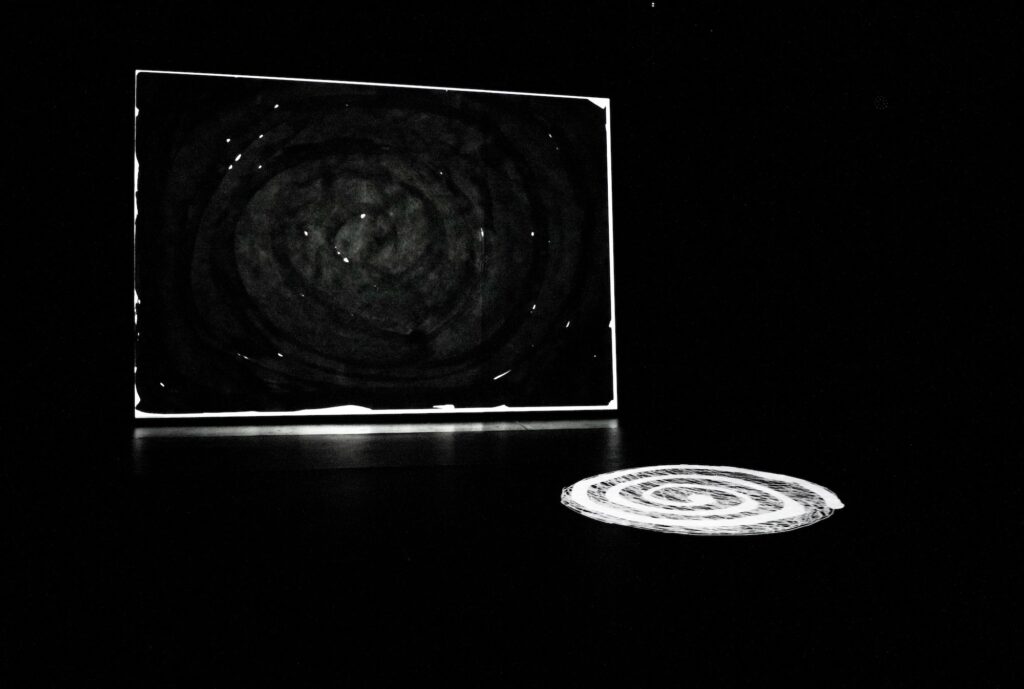
27. Glück: You who do not remember / passage from the other world / I tell you I could speak again: whatever / returns from oblivion returns / to find a voice.16
28. I have seen numerous shows at Red Eye, a theater that thrives as a safe place for risk-taking. So it’s with a modicum of familiarity that I make this observation: I have not witnessed an audience exhibit more discomfort at Red Eye than that night at I Can See The Sky, and, in particular, it seemed most palpable at A.P.’s invocation of God. Was it that? Or their otherworldly slowness in movement? Their oracular mode? Their weeping? In A.P.’s abjection at rock bottom, making wonder and song out of it (hell heals), they have picked up all the pieces, including the taboo among their shards, and gotten to the holy, existential kink of surrender.
For the record, I’ve learned that the previous night saw a much more enthusiastic and responsive crowd, one night the yang and the other the yin.
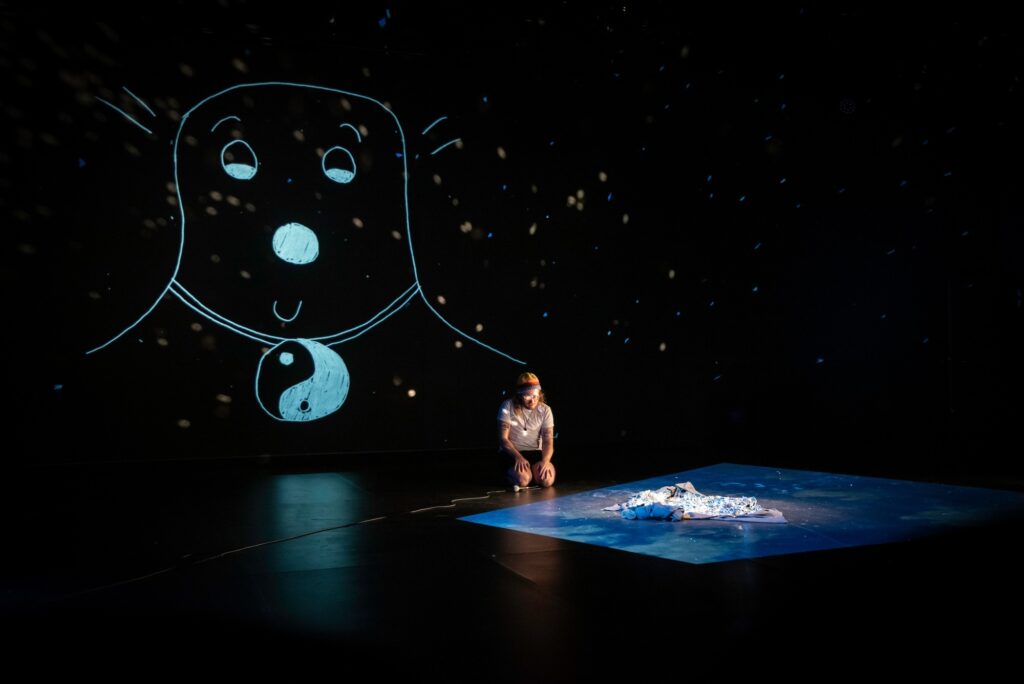
29. Among angels, artists, astrophysicists, those who’ve been through AA, and mystics, we find unapologetic invocations of the metonymic divine– god with a capital G, mystery, the creatrix, higher power, source. God, literally and figuratively, is everywhere in the pages of Einstein, Hawking, and the great poetry-loving physicist, Carlo Rovelli, who picks up where Stephen Hawking left off at the end of time in a black hole.
30. Glück: from the center of my life came / a great fountain, deep blue / shadows on azure sea water.17
31. In I Can See The Sky there are manifold energies, many I’s, many looping refrains in an A.P. choir. It’s a space of two directions at once, like a wave, and shares the dispersiveness of that phenomenon. Expressed by light. A space of refraction. I open a book that arrived today, and chance provides: “It may happen that you visualize yourself as lying at the bottom of a well and feel the well seemingly in lively downward movement. In reality it is you who are moving upward.”18
32. In AP’s metonymic grammar the subject of god mutates into time. Time mutates into sky. Sky mutates into the elasticity of the universe, and its endlessness. That’s what we find at the bottom of the black hole, after the purported end of time, the bounce back, the leap. Writes Rovelli: The leap beyond the end of time predicted by relativity can happen: it is predicted by quantum theory. Like all quantum “leaps,” it is a break, a rupture of continuity . . . a world more complex than a simple spaciotemporal continuum. I appreciate that Rovelli turns to Dante to help illustrate–the Dante, who from the depths of hell makes a rapid ascent to the edge of the known universe: Dante himself stares into the sun. He is flooded with light. . . “It seemed then that so much of the sky was lit.” There is nothing else, in the leap, but a lake of light . . . “And suddenly it seemed that a sun was added to the sun.”19
Performance credits for I Can See The Sky:
Directed by Ellen Marie Hinchcliffe
Presence Teachings from Masanari Kawahara
Technical Wizard: Peter Morrow
Lighting Design: Heidi Eckwall